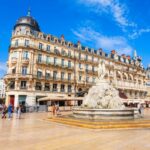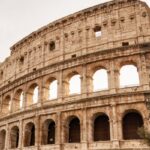A trip to Alberta, with places like Jasper and Banff, is a photographer’s paradise. These are 10 top photo spots in Alberta, Canada.
Must Read: marketing technology landscape supergraphic 2018 martech 5000 actually 6829
Alberta has some of the most beautiful landscapes in the world, including mountains, rivers and lakes, forests, prairies and forests scattered throughout the province. It was difficult to narrow down the beauty to just a few spots.
Athabasca Falls
Athabasca Falls, a stunning waterfall that flows from the Athabasca River, is one of the most impressive in the Canadian Rockies. It measures 23 meters tall. The falls themselves are stunning, but when viewed against the Mount Kerkeslin background, they look even more impressive.
However, the mist from the falls can create slippery conditions. Keep your feet on the paved paths!
Johnston Canyon
Johnston Canyon, located in Banff National Park is home to waterfalls and a forest. It also has a creek and canyon walls that reach up into the heavens. We recommend visiting Johnston Canyon in winter to see the dramatic icy landscapes and the ice walking tour, but this spot is great for photography all year.
Never Miss: michigan citizens property insurance
The Icefields Parkway, also known as Highway 93N, runs through Banff National Parks and Jasper National Parks. It is rated one of the most beautiful drives in the world. You will travel along a double-lane highway that runs for 232 kilometers through mountains, valleys, ice fields and other scenic areas. We guarantee you will stop along the route to take photos every chance that you get.
Lake Louise
Lake Louise is located just an hour east from Banff. It’s a stunningly blue-hued lake that is surrounded by majestic picturesque mountains that seem to hold up Victoria Glacier. You should note that Lake Louise can be quite crowded in summertime so the best shots are either from the water, or from one of the hiking trails.
Maligne Canyon
Maligne Canyon, located at the entrance of Maligne Valley, Jasper National Park is the deepest canyon and is well-known for its chilling atmosphere. The canyon is stunningly beautiful at any time of the year. However, the waterfalls that tumble over in winter offer some amazing icy photography opportunities.
Six bridges span various points to help you explore the canyon and capture some amazing shots.
Maligne Lake
Maligne Lake, a pristine lake with crystal clear water and surrounded by glaciers, is about an hour drive from Maligne Canyon. It is also the second-largest lake of glaciers in the world. Spirit Island is the center of this azure-blue lake. Renting a kayak is the best way to get the best shots of Maligne Lake.
Moraine Lake
Lake Moraine, located in Banff National Park, is just 14 km from Lake Louise. It is a glacially-fed lake that is surrounded by mountains. This spot is stunning all year round, but it’s even more impressive in June when the glaciers melt to make the lake a turquoise-blue hue.
Two Jack Lake
Two Jack Lake, located north of Banff, is a popular spot for photographers because of its beautiful pink and purple sunsets. Two Jack Lake’s still waters will provide stunning shots of the mountains and trees that are reflected in them.
Most Popular: what is digital marketing
Lake Minnewanka
Minnewanka, a glacial lake created by man in eastern Banff National Park is well-known for its blue waters, and in winter, the Northern Lights. You’re correct, Lake Minnewanka can be seen in the Aurora Borealis when conditions are favorable. This makes it a great spot for amazing photography!
Banff Town
You can enjoy stunning landscape views and a taste of the local culture while exploring Banff National Park. Take a ride on the gondola to capture stunning views of Banff and stroll around the town for some mountain-town charm.
Photo Gear Packing Essentials
Camera Bag: We recommend the PacSafe Anti-Theft Camera Backpack or the Kattee Fashion Canvas Camera Backpack to carry your equipment around.
Additional SD Cards: Keep extra SD cards handy. We recommend the 64GB SD Class 10 SD Card or the Eyefi 32GB Class 10 SD Card for WiFi.
Camera Protection: We recommend that you protect your camera equipment by packing a rain sleeve and microfiber lens cloth. To avoid camera accidents due to water, we recommend purchasing a GoPro if you are going on or near water.
Also Read: did you know that watches tells about their owners
Compact Tripod: A compact tripod is essential for taking photos of the Northern Lights or selfies. Our Ultimate Packing Guide for Travel Photographers has more packing tips!


